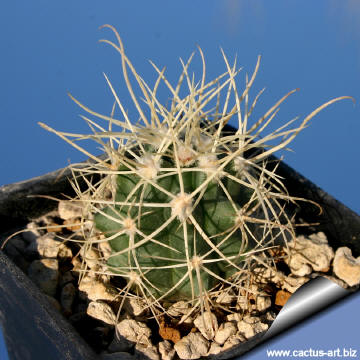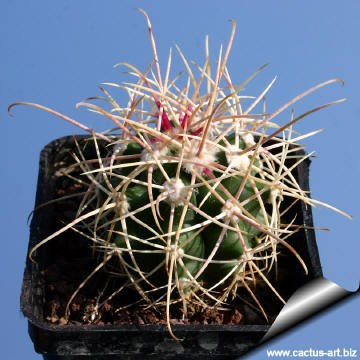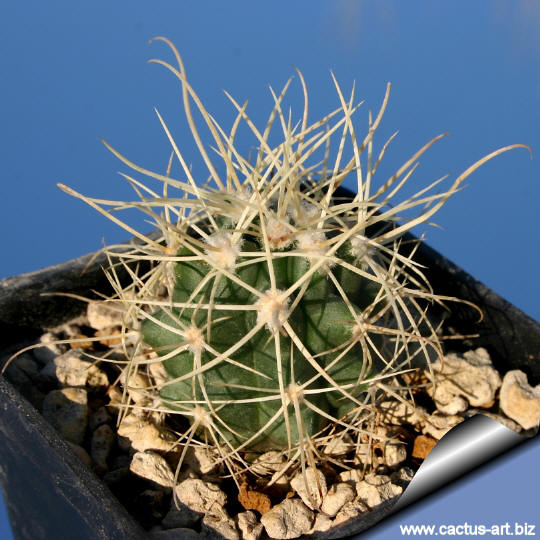|
|
|

Ferocactus acanthodes "albispinus"
This is the nice and uncommon pale form. Spines are pure white or
shaded with pink for a provisionary time only in the new growth.
|
 |

|
|
.
|
 |
 |
|
Propagation:
Seeds are the only way of
reproducing.
Seed
Collecting: Permit
fruit to
ripen.
Fruit must be significantly
overripe before harvesting seed; clean and dry seeds
|
|
Advertising
|
|
|
|
|
Family:
Cactaceae (Cactus
Family) Ferocactus
acanthodes forma albispina
Scientific name: Ferocactus cylindraceus "albispinus"
Origin:
Garden origin (Nursery
form derived by repeated
selective breeding from pure white spined plant).
Synonyms:
- Echinocactus cylindraceus
- Echinocactus viridescens var. cylindraceus
- Echinocactus acanthodes
- Ferocactus acanthodes
|
|
Description: The plant is usually
unbranched, forming a
single column up to 2 (3) m tall and 30cm in diameter. The ribs are
2.5cm high and tuberculate.
Spines: A large central spine and three
auxiliary centrals form a crucifix shape, The primary central is
7-15 , angles down and is slightly to moderately
hooked, sometimes to 90 degrees. The other centrals are from 5 to 7.5 cm
long. The centrals are noticeably ring
ridged and flattened,
with a flat upper surface and rounded lower surface. Spines are pure
white to very light grey (shaded with pink only in the new growth).
Flowers: Yellow flowers tinged with red appear in May and June at
the crown of the plant, 4 to 6cm. The fruit with scales is fleshy,
yellow or yellowish green 5cm long, 2.5cm in diameter.
The flowers on all subspecies are yellow.
|
|
|
|

Cultivation:
They are summer-growing and pretty easy plants thought
slow to start. They are suited for any rich, well
drained soil such us clay, pumice, lava grit, and only a little
peat or leaf-mould. If potted, repot them preferably in the spring, if their
roots become cramped. Generally, they should be repotted every
other year in order to provide fresh soil. However, this doesn't
necessarily mean they'll need larger containers. Fill about a quarter of
the pot with broken crocks, gravel, etc. to promote good drainage. After
repotting, do not water for a week or more. Water regularly during the
aestival growth cycle (this plant need plenty of water, but do not
overwater and let their soil dry out between waterings),
and also needs to be avoided wetting the body
of this plant while it is in sunlight. A wet cactus in the sun light can
cause sun burning which can lead to scares or even fungal infections and
death, keep rather dry in winter. No water should ever be allowed to
stand around the roots. Feed with a high potassium fertilizer in summer.
Exposure: Outside they need a bright exposure,
full sun or half shade in summer if the location is exceedingly hot or
bright, inside needs bright light, and some direct sun.
It can tolerate moderate shade, and a plant that has been growing in
shade should be slowly hardened off before placing it in full sun as the
plant will be severely scorched if moved too suddenly from shade into
sun.
Frost Tolerance: Light frost protection required for
safe cultivation, but can tolerate sporadic light frost. This
plants need a period of cool rest in winter to produce flowers
abundantly.
Diseases and pests:
Watch for infestations of
mealybug, scale insects and spider mite.
Plant in good conditions will
start to bloom when reach the diameter of only 15-18 cm.
Photo of conspecific
taxa, varieties, forms and cultivars of
Ferocactus cylindraceus:


|
|